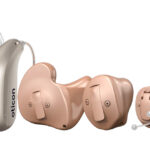The idea of an invisible hearing aid is an appealing one and perhaps as many as 70 per cent of first-time hearing aid users are interested in the idea of a hearing aid that cannot be seen when in use.
Of course, like most things, there are advantages and disadvantages and there will inevitably be some trade-offs if a truly invisible hearing aid is your choice.
Advantages of invisible hearing aids
1 They are invisible. Invisible-in-the-canal (IIC) hearing aids, to use the technical term, are the smallest devices available. This means they sit furthest down your ear canal where no casual observer will ever see them. There are also no wires or earpieces visible on the surface so to all intents and purposes they are truly invisible.
2. They work well in most environments. IICs essentially plug the ear canal so are very good at eliminating background noise. This means that in situations like business meetings or meals in restaurants, an invisible hearing aid should be up to the job.
Good for active lifestyles
3 They wirelessly connect to TVs, computers, phones and other devices. Modern hearing aids need to link effortlessly with the technology you use everyday and IICs won’t let you down in this regard – they offer excellent compatibility.
4 They are good for active lifestyles. Each IIC is custom-moulded to the shape of your ear, so they fit securely and can be worn for sports and other physical activities. This is a huge benefit if you don’t want to remove or risk damaging your hearing aid every time you go for a run or play a team sport.
They use less energy
5 Some users find they provide a more ‘natural’ sound. This is a slightly subjective issue, but because IICs don’t interfere with the sound-shaping contours of your outer ear, the quality of sound they produce is often described as ‘natural’ or ‘uncoloured’. For the same reason, they also allow your ear to continue identifying which direction sounds are coming from.
6. They use less energy. Because IICs sit so far down your ear canal, they require less volume to produce the same perceived loudness as other aids. This also means there is less residual sound bouncing around your ear canal, which can cause feedback when using the phone.
Disadvantages of invisible hearing aids
1 They aren’t great in very noisy environments. Because of their size, IICs only have one microphone which means they can’t support the directional features of their larger relatives. In environments such as busy restaurants and bars, aids with multiple microphones can help you focus on a speaker in front of you by reducing the volume of sounds emanating from the back and sides. By contrast, IICs amplify sounds coming from all directions equally. As microphone technology improves, the sound quality and directional ability of even the smallest hearing aids is improving, but if you want the very best hearing in noise, a mult-microphone device is still the best option.
2 They aren’t powerful enough for severe hearing losses. The laws of physics mean that powerful speakers are inherently larger, so while IICs can provide an excellent solution for people with mild or moderate hearing loss, they aren’t suitable for people with profound hearing difficulties.
Not everyone can wear them
3 They have a relatively short battery life. Another unavoidable limitation of such a device is the size of battery the manufacturers are able to use. If you don’t like the idea of regularly recharging or replacing batteries then an IIC might not be the best choice for you.
4 The occlusion effect. Most of the sounds you hear – people talking, music, birdsong and so on – enter your ears from the outside. However, the vibrations from your own voice also reach your ears directly through your body. Having taken this ‘short cut’, some sound waves would naturally escape up your ear canal. However, when you’re wearing an IIC, this will prevent the sound waves leaving your ear canal. As a result, some people find their own voice sounds different or louder when wearing a hearing aid. However this only affects a minority of people.
5 Not everyone can wear an IIC. Like every part of the human body, ears come in all shapes and sizes. In a few instances, we find that an individual’s ear canals are too short, narrow or shaped in such a way that it is not possible to successfully fit an IIC. Depending on the shape of your ear canal, there is also a risk that they might work themselves loose while chewing or talking. Similarly, if you have a problem with your eyesight or movement that prevents you from successfully placing the device in your ear, you might be better suited to a slightly larger hearing aid which is easier to position.
6 They require more maintenance. Because IICs sit further down your ear canal, they are more likely to suffer from problems related to ear wax building up around the microphone part.
Is an invisible hearing aid right for you?
A hearing aid should give you the freedom to live the life you want. For some people, having a device that nobody else can see makes IICs the only type of hearing aid worth considering.
However, many people decide that, on reflection, they would rather forego invisibility for a device which gives them more function and convenience.
Your audiologist is the best person to advise you on these issues and you can arrange an appointment at any of our private clinic locations to discuss things further.

